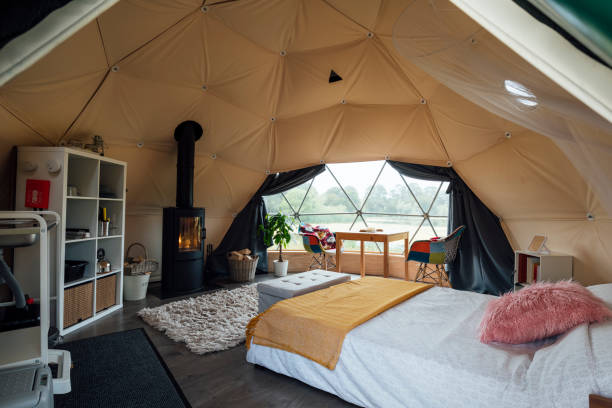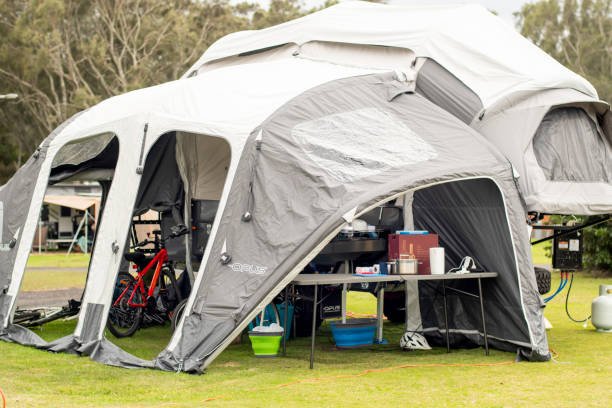Inflatable tents with wood stoves are revolutionizing camping and outdoor adventures. These ingenious shelters combine the portability and ease of an inflatable tent with the warmth and ambiance of a wood-burning stove. This allows campers to quickly set up a sturdy shelter and stay warm no matter the weather or location.
In this article, we’ll explore the benefits of inflatable tents with wood stoves, what to look for when purchasing one, how to set it up and use it safely, and recommendations for the best models on the market today. Whether you’re a backpacker, a car camper, or just enjoy relaxing in nature, an inflatable tent with a wood stove can enhance your experience tremendously.
Benefits of an Inflatable Tent with Wood Stove
Here are some of the key benefits that make inflatable tents with stoves so advantageous:
Portability
- Inflatable tents fold up into a compact carrying case that can be easily transported by car or backpacked into remote locations.
- When deflated, they take up very little space and are lightweight compared to traditional tents.
- This makes them ideal for car camping, hunting trips, fishing excursions, and backcountry adventures where minimizing gear bulk and weight is a priority.
Quick & Easy Setup
- Inflatable tents can be set up in just a few minutes by attaching the stovepipe, staking down the base, and pumping up the inflatable beams with an electric or manual air pump.
- Installation is straightforward and does not require extensive pole assembly like traditional tents.
- Once inflated, the beams are rigid and provide ample interior space. Deflation and packing up are just as simple for a quick takedown.
Strength & Stability
- The inflatable beams provide vertical support and cross-linking within the tent to create a sturdy structure capable of handling snow weight and high winds when properly staked down.
- High-quality inflatable tents feel solid when erected and will not sag or sway. The durable outer fabric is designed to withstand tearing and abrasion.
- Wood stoves feature metal construction and are engineered specifically for heating tents safely, with proper clearance and heat shielding.
Warmth & Coziness
- Wood stoves provide comforting radiant and convection heat powered by readily available firewood – no need for electricity or propane.
- The interior warmth allows for comfortable camping in cold weather conditions where traditional tents would be frigid.
- The glow and ambiance of a real wood fire create a cozy atmosphere and a natural gathering spot for relaxing.
Adaptability & Functionality
- Inflatable tents provide versatility to camp in varied terrain from woodlands to open meadows, deserts, beaches, and snow.
- Their ease of transport and rapid setup allow you to pitch them and start a fire quickly if bad weather moves in unexpectedly.
- High-quality inflatable tents have vents and windows that can be closed or opened as desired for climate control.
- Some models have separate screen rooms or awnings that provide additional covered living space.

What to Look For in an Inflatable Tent Stove
Tent Design
When evaluating inflatable tents, look for:
- Durable outer fabric that is thick, rip-resistant, weatherproof, and has a high denier rating of 600D or more. Reinforced panels along the base improve durability.
- Inflatable beams that are thick and made from puncture-resistant material. Multiple cross-linked beams provide better structural stability and support.
- Waterproof floor made from thick anti-abrasion material to withstand ground moisture and debris. Taped or sealed seams prevent leaks.
- UV protection like reflective outer coatings helps shield the inner tent from sun damage and overheating.
- Doors and windows made from mesh, canvas panels, or vinyl shields provide versatile ventilation and weather protection.
- Easy inflation ports allow quick inflation of beams using electric or manual pumps. A tight outer valve seals in air pressure.
- Guy lines and stakes to securely anchor the tent in high winds. Loops positioned for optimal stability. High-quality stakes included.
- Carry bag that fits all tent components and has straps for easy handling. Compact, lightweight, and durable.

Stove Design
Look for wood stoves designed specifically for heating tents safely:
- All-steel construction with a 1.2mm minimum thickness for durability under frequent heating.
- Secure pipe connections using locking bands, not screws, for a tight seal.
- A double-wall stove pipe with an open-air gap to prevent burns from accidental contact.
- The spark arrestor cap prevents embers from escaping through the chimney.
- Stable base with wide, angled legs for leveling on uneven ground without tipping.
- The front door with latch allows easy loading of wood while providing a flame barrier.
- Slide-out ash pan makes cleanup simple.
- Primary air intake to control oxygen flow and heat output.
- Painted outer finish or porcelain enamel coating resists corrosion and adds aesthetics.
Tent & Stove Compatibility
- Ensure the stove and pipe are designed for the tent’s dimensions to maintain proper clearance distances.
- There should be a 24-inch minimum clearance from stove to tent fabric per safety codes.
- Stove pipe openings and collars must be compatible with the tent stove jack size and material.
- The stove weight capacity should match the tent’s specifications with at least a 10-20% buffer.
Quality & Reliability
- Read customer reviews to gauge real-world performance and longevity.
- Look for reputable manufacturers that specialize in tent stoves and stand behind their products.
- Consider a direct purchase from a company website over third-party sellers for warranty support.
- Higher cost often equates to better construction, materials, and engineering.
Setup Best Practices
Properly setting up your inflatable tent with a wood stove is key to comfort and safety:
Location
- Carefully clear the area of debris, branches, and rocks that could puncture the tent floor. Avoid overhanging limbs.
- Select a flat site for the best stove stability. Slope grades over 5° often require digging a level foundation or using supporting boards underneath the stove.
- Face the tent entrance away from the prevailing wind direction to prevent smoke backdrafts inside when loading wood.
- In deep snow, tramp down a firm base and wait for the stove to melt the shaded area beneath it before firing up.
Inflation
- Inflate beams mid-way first, then alternate around the tent to distribute pressure evenly as it expands.
- Inflate to the recommended air pressure level; not under or over. Use a pressure gauge for accuracy.
- Close air valves tightly and check for leaks around fittings. Re-inflate as needed after setup.
Anchors
- Anchor the tent at all corner guy line points and stake loops first before raising the frame.
- Use all provided stakes and hammer them firmly at a 45° angle through anchor loops into the ground.
- If soil is loose or sandy, use screw-in earth auger stakes for maximum hold.
- Make sure the tent floor and walls remain taut with no major sagging when staked.
Stove Assembly
- Attach stove pipe sections with locking bands using the provided tools. Tighten firmly.
- Insert assembled pipe through the stove jack collar in the tent roof until the spark arrestor end protrudes adequately.
- Position the stove inside, line up the pipe connection, and turn to lock it in place securely.
- Place the stove on a fireproof base like a concrete patio block or stones if not already integrated.
Safety Checks
- Verify the stove is placed at the recommended distance from tent walls, roof, and openings per specifications.
- Ensure the stove sits level and steady once loaded. Use wood planks to level on uneven surfaces.
- Confirm that pipes and connections have no major gaps or loosening that could allow sparks through after warming up.
- Keep a fire extinguisher, shovel, buckets of water nearby in case of emergencies or flare-ups.
- Inspect the site for burn hazards and maintain proper ventilation when occupied.
Operating a Tent Stove Safely
Burning wood inside a tent requires caution. Follow these tips to prevent accidents and asphyxiation:
Ventilation
- The tent must have adequate ventilation to feed the stove with fresh air and evacuate smoke.
- Windows, doors, and ceiling vents should remain partially open whenever the stove is burning.
- Position the stove where air can freely circulate it.
- Open all vents fully for 5-10 minutes to purge any remaining smoke after re-loading the stove before damping the vents down.
Fuel Materials
- Use only approved dry firewood up to 18″ long. Softwoods like pine kindling are best for starting fires.
- Never burn wet, rotten, moldy, or painted wood which can emit toxic smoke.
- Avoid burning logs with nails, screws, or very thick bark that may spark.
- Do not use any flammable liquids like gasoline, kerosene, lighter fluid, or propane to light or feed the fire.
Operation
- Adhere to the stove’s burn time limits and refueling cycles to prevent overheating or gas buildup.
- Do not overload the stove with too much wood at once. Start small and gradually add more over time.
- Control the fire by adjusting the primary air intake damper, not by fully closing vents.
- Let the stove and pipes cool fully before disassembly to prevent burns or damage.
Monitoring
- Stay alert and monitor the fire at all times. Never leave an actively burning stove unattended.
- Watch for flickering flames, smoke backdrafts, or leaks indicating issues with airflow.
- Use a stove-top thermometer to check flue temperatures and avoid overheating.
- Have an evacuation plan ready in case of emergency.

Tips for Living in an Inflatable Tent
Inflatable tents make comfortable shelters but still require some adjustment from standard house living. Here are some pointers:
- Prevent condensation by leaving ceiling vents partially open to allow air circulation, wiping down walls, and avoiding high-humidity activities like drying wet clothes inside.
- Insulate the floor with closed cell foam pads, thick blankets, or even a fitted mattress to prevent cold from radiating up from the ground.
- Use battery or propane lights to illuminate the interior instead of candles which deplete oxygen. Bring extra batteries.
- Cook outside over a separate fire pit or camp stove to avoid food smells and excess moisture inside the tent.
- Secure all openings at night and when away to prevent pests or rodents from entering. Stash all food securely as well.
- Shake off your shoes before entering to keep a tidy interior free of dirt, grass, and mud. A doormat helps reduce tracked-in debris.
- Allow inflatable beams to expand and contract with temperature. Don’t force windows or doors closed on cold mornings.
- Pitch sun shades using tarps or detachable tent flies to reduce solar heating on hot sunny days if the tent lacks integrated shading.
- Keep a low profile in high winds by sitting or sleeping low to the ground where tent movement is minimized.
Top Inflatable Tent Wood Stove Models
Kni-Co Trekker Stove Package
- Lightweight model good for frequent relocation.
- Folding stove legs allow the stove to nest inside the pipe for transport.
- Available tent packages tailored for the stove.
Tiny Wood Stove 2.0 + Tent Bundle
- Ultralight stove rated for tents down to 80 sq. ft.
- The Mesh door provides good views of the fire.
- The matching tent is easy to pitch and rugged.
Winner will Nomad Medium Tent Stove
- Powerful heat output for larger tents up to 200 sq. ft.
- Built-in storage shelf and cool-touch handle.
- Pair with their Fast-Pitch cabin-style tents.
Drolet Pioneer Tent Stove
- Rectangular firebox accepts longer logs.
- A blower kit is available for heat circulation away from the stove.
- Under $300 stove price point.
Northwestern Suppliers wall tent packages
- Complete tents with custom stoves and pipes included.
- High-end materials and construction quality.
- Made to order with customization options.
Frequently Asked Questions
Is it safe to have an open flame inside an inflatable tent?
It is safe when using a proper wood stove and tent designed specifically for stove use, following all setup guidelines, and operating the stove cautiously. Always maintain clearance from combustibles and ventilation.
How long does it take to heat an inflatable tent?
With a well-loaded stove burning on high, an inflatable tent can reach comfortable temperatures around 65°F within 30-60 minutes depending on initial air temperature and tent size. Smaller tents heat up quickly.
What is the best wood to burn in a tent stove?
Dry softwoods like pine, spruce, and cedar make excellent kindling, catching quickly with hot flames. Hardwoods like oak, maple, and ash burn longer, producing lasting coals but need softwoods to start. Avoid wet or rotted wood.
Where can you buy replacement stove pipes?
Many tent stove manufacturers sell replacements directly through their websites. Generic single-wall black stove pipe can also be obtained at most hardware and home improvement stores by measuring pipe diameter.
How much wood does a tent stove burn through per day?
On average, a medium-sized tent stove burning 6-8 hours will require between 5-8 lbs of dry split logs to maintain comfortable heat, or around 1/3 to 1/2 cubic foot stacked.
What is the best way to clean a tent stove flue?
Remove all ash first into the collection pan. Then take a flue brush on an extendable rod and vigorously brush up through the pipe from inside the stove to dislodge soot deposits. Finish by sweeping out all residue.
Can you install a tent stove permanently in a cabin or wall tent?
Tent stoves are designed for temporary shelter heating only and are not approved for permanent home installation where building codes apply. Consult a professional about installing a wood stove or stove insert compliant with local regulations.
How do you prevent an inflatable tent from overheating with a stove inside?
Open windows, doors, and ceiling vents fully to circulate air. Let the tent cool before closing the vents up at night. Refuel the stove minimally. Use a thermometer and don’t let interior temperatures exceed 75°F.
Are tent stoves legal on public lands and in national parks?
Regulations vary. Always check campfire and stove restrictions for the specific area beforehand. In general, enclosed stoves are subject to less restrictions than open campfires. Many public lands allow canister-type portable stoves.
My Closing Thoughts
For serious campers, hunters, or anyone wanting to enjoy nature in comfort, an inflatable tent with a wood stove provides the ultimate portable shelter. They allow you to escape crowds and set up a warm, cozy camp anywhere with minimal hassle thanks to modern materials and engineering. With proper setup and safe operation, these tent stoves grant almost as much amenity as home while still immersed in the beauty of the outdoors.
Whether you seek adventure away from civilization or just want a weekend getaway at your favorite remote campsite, pairing an inflatable tent with a compact wood stove can make your next nature excursion safer, warmer, and more enjoyable than ever.









